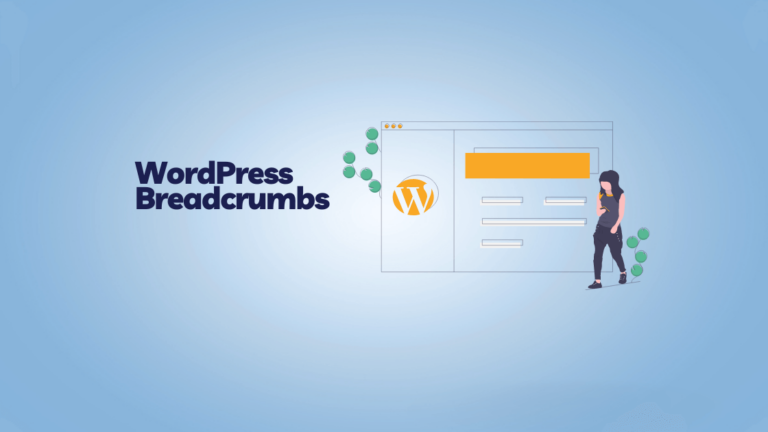How To Write Blog Descriptions [2024]: No More Mistakes!
Are you looking for the proper guide to creating compelling blog descriptions?
You are at the right place!
If you are thinking of getting HIGH traffic from Google searches, you should start focusing on the basics first.
Creating a compelling blog description (i.e. meta descriptions) is the first task you need to do after launching your blog online.
A proper blog description can increase your website traffic dramatically.
In this article, I have covered everything you need to know about writing a compelling blog description and post description.
Let’s have a look at what I have covered here:
- What is a blog description?
- Difference between a blog description and a blog post description
- Great blog description examples
- The best way to describe your blog (and blog posts) and much more
Without further ado, let’s learn more about the Blog description and post descriptions below-
Every step of this article is vital for you if you don’t have any idea about the blog description and post description. So read every single point so that you don’t miss any important points.
- Blog Description: Everything You Need to Know
- Difference Between Blog Description and Blog Post Description
- 5 Great Blog Description Examples
- Why Your Blog or Website Needs a Powerful Description?
- How To Write A Powerful Blog Description
- Tips For A Great Blog Post Description: How To Write One?
- Blog Description Tips for Increasing CTR With Keywords?
- How to Write Blog Description on Blogger?
- Top 3 Meta Description Generators
- FAQs About Blog Descriptions
- Final thoughts on blog post description
Blog Description plays a vital role in search traffic. This is the only ranking factor that you have to optimize well for getting more licks. Otherwise, you will get a high impression but end up with low clicks. So read this whole content carefully and optimize your content according to the hacks I have mentioned here to increase CTR in Google SERP.
Blog Description: Everything You Need to Know
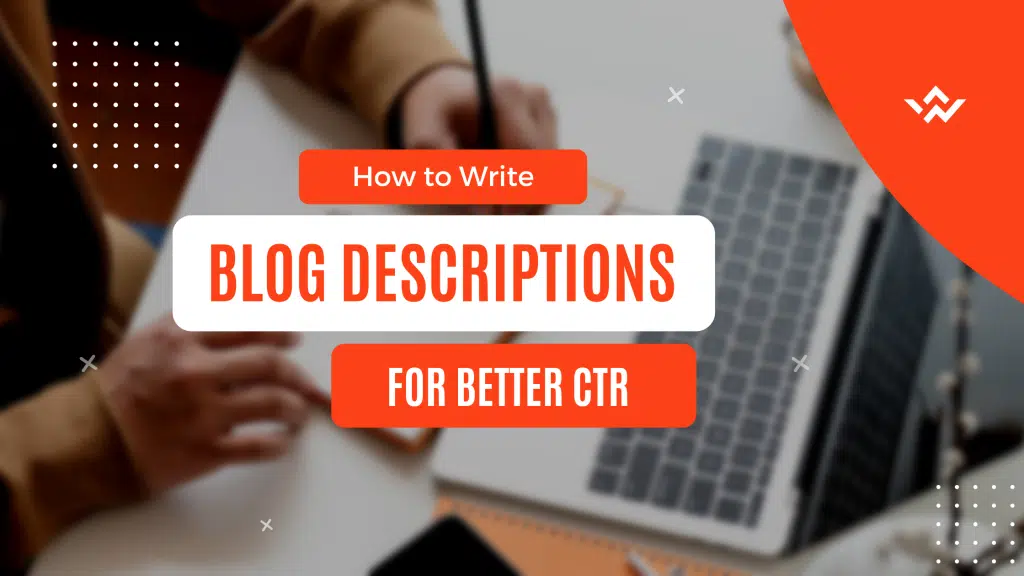
What is a Blog Description?
A blog description summarizes the content of a website. When visitors click on search results, search engines display a description of a blog or website.
The following is an example of a blog description on our site.
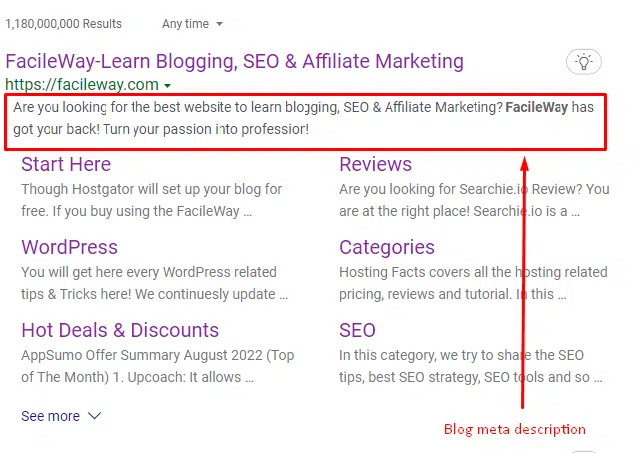
Benefits of blog descriptions:
The following benefits can be derived from blog descriptions.
- You can improve your website’s organic click-through rate by writing blog descriptions
- Conversions and sales of your website will be impacted by them
- They will enhance your website’s indexing, allowing you to rank higher in search results
- It will make your site more appealing to the target audience
Difference Between Blog Description and Blog Post Description
There are two types of descriptions:
- Blog description
- Blog post description
This post will discuss the differences between blog descriptions and a post description with real-life examples.
1. Blog Description:
Your blog description appears beneath the link to your site in SERP (Search Engine Results Page).
Here’s an example of a blog description;

The blog description appears below the homepage of the blog, as shown above.
2. Blog Post Description:
You can find the description of your blog post on search engine results pages, below the link to your blog post. Individual blog post descriptions will appear on the search engine results pages under the post title and post a link.
The following is an example of a Blog post description;

The blog description appears below the title of the blog post, as you can see above.
There is a 5.8% click-through rate increase between pages with a meta description tag and those without.
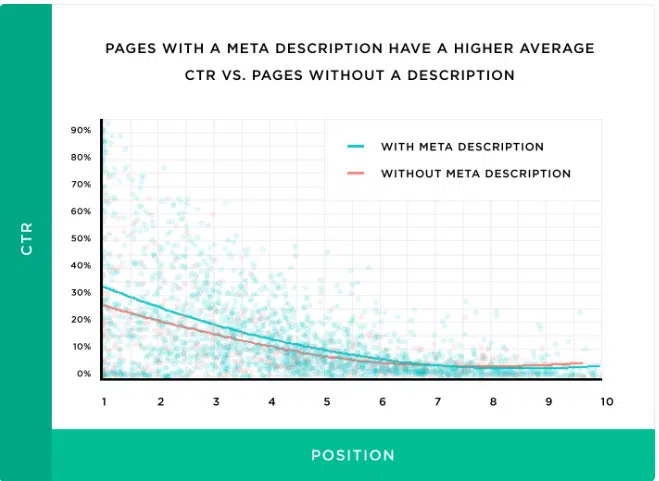
Every time you publish a blog post, make sure to write a meta post description.
5 Great Blog Description Examples
Are you looking for great examples of blog descriptions?
The following are some of the best blog descriptions from a variety of industries.
Example 1: Fiverr

Why it’s great?
Fiverr is one of the best freelance marketplaces where buyers and sellers feed their needs.
Their meta blog descriptions say it is all about the platform.
Anyone can understand what the website is all about. This is the beauty of a good blog description.
Example 2: LinkedIn

Why it’s great?
LinkedIn is the number of platform for professional gathering.
You can see their blog descriptions, you will understand that this platform can be a great medium for professional networking and engagement.
That means by simply reading a blog description anyone can understand that their professional life can be improved using this platform.
Example 3: Binance

Why it’s great?
Binance is the leading cryptocurrency exchange out there. If you check their blog description, you can see that they are showing what the website is all about.
Example 4: TravelPayouts

Why it’s great?
TravelPayouts is the best affiliate platform for Travel Bloggers. If you notice their blog descriptions, you can see that you can run your travel blog only without this platform and without any issues.
You will get what you need to make your travel blog successful.
Example 5: Flippa

Why it’s great?
Flippa is the most trusted website for selling websites and online businesses.
If you have a blog or website that has grown enough you can sell the website on Flippa with very good revenue.
The Flippa blog description shows that this website is related to website buying and selling.
Why Your Blog or Website Need a Powerful Description?
Your blog’s description is not just a random blurb that people might see.
It’s one of the most important pieces of information that users read when deciding whether or not to click on your blog.
If you don’t optimize your blog’s description, you are likely going to lose potential followers and readers.
The first thing you should do is install an optimization plugin such as Rank Math. There is also a free version, which is fantastic.
The Rank Math SEO plugin allows you to easily edit your blog’s homepage description.
You can find the Homepage tab in Titles & Meta once you install the Rank Math plugin.
This is what it looks like;
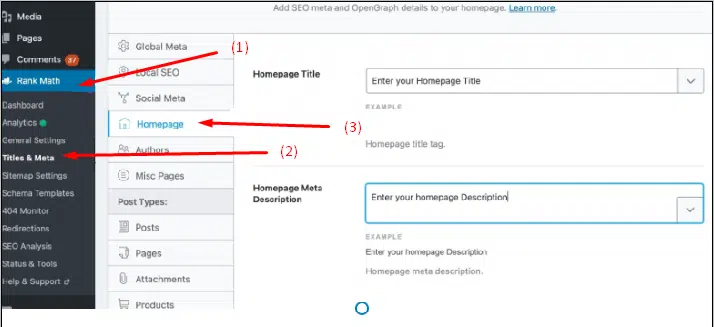
You can add a description for your blog in the homepage title and homepage meta description, as shown above.
How To Write A Powerful Blog Description
How to write a blog description? It can be challenging to write a blog description that will be eye-catching at the same time information about your whole website category.
Here I have brought to you some amazing hacks, for writing effective blog descriptions that will be easier for you.
You can create a compelling description for your blog or website by following these 5 amazing tips.
1. Explain What Is Your Blog All About:
It is common for blog descriptions to be 120 to 158 characters long, with a maximum width of 920 pixels. Your site should explain what it is all about in as few characters as possible.
Identify your competitors’ websites and analyze them. Discover how authority websites create their blog descriptions.
Your blog description should be based on inspiration.
The following is an example of a great blog description;

With a few characters in its blog description, FacileWay explains what its blog is about in a compelling way.
2. Include your primary keywords:
The blog description must contain your main keywords naturally. Your site’s purpose will be understood by search engines like Google in this way.
Here is the description of the “FacileWay” blog.

In the description of the FacileWay blog, several keywords are included that are all relevant to the blog. Your blog description can also contain highly relevant keywords to attract more search visitors.
3. Display your expertise:
Exposing your expertise is a great way to make your blog’s description unique and powerful.

The following is an example of Mathew Woodward’s blog description, showing his expertise in increasing search traffic.
You can see that he has mentioned some of his award-winning tutorials.
4. Include benefits:
When writing your blog description, be sure to include benefits that will entice your target audience.
If they visit your blog, tell them what’s in it for them.
After landing on your blog, what benefits will they receive? Google will send more visitors to your blog if you describe its benefits concisely.
You can see how Medium is benefiting its users-

The benefits of using Medium’s platform can be seen above. It’s probably a good idea to create an account on Medium if you’re interested in knowledge sharing.
5. Add credentials:
If you already have an online presence or a large following, you should definitely mention that in your blog description. It definitely helps to add credentials to your resume.
The best in the business is Cloudways;

Over 70,0000 Agencies, developers, and small businesses trust Cloudways worldwide. You can see the credentials above in the image.
Tips For A Great Blog Post Description: How To Write One?
Are you interested in learning how to write blog post descriptions that get more organic traffic and clicks?
These tips will help you create the perfect meta descriptions for your blog posts and reduce the bounce rate.
1. Use questions:
When writing blog posts, we often use questions. Their ability to create instant curiosity often works like a charm.
I will give you an example;

Our blog post’s description uses a question to increase clicks, as you can see above.
2. Use power words:
Using power words in your blog post description is a great way to entice your readers.
An emotional response is triggered by powerful words that are enticing and descriptive.
These are some of the power words;
- outstanding
- killer
- effective
- compelling
- free
- deals
- exciting
3. Don’t use clickbait:
Blog post descriptions are typically filled with clickbait headlines to attract more traffic and clicks.
In reality, clickbait headlines mislead your website audience as they contain misleading wording instead of using the right words that are relevant to the content.
It is always a good idea to write descriptions that match your content. Don’t try to trick your audience by using clickbait headlines to get them to click your link.
4. Implement structured data:
Make sure your blog post descriptions are structured if you want them to be persuasive.
Search engines are able to understand the information provided on a webpage more easily when structured data is used.
There are several types of structured data metatags, including star ratings for product reviews, business names, and addresses.
An example of a structured data-driven start rating;

Blog Description Tips for Increasing CTR With Keywords?
Is there a BEST way to get more visitors to your blog posts from search engines? Your blog description can get better results if you follow these proven methods.
1. Include Your Primary Keyword In Meta Descriptions:
It’s important to pay attention to your meta descriptions.
Meta descriptions are HTML attributes that provide a brief summary of a website.
When writing your blog posts’ meta descriptions, keep your target keywords in mind.
Is that possible?
Every time you write a blog post, conduct keyword research.
In your blog post descriptions, include at least ONE primary keyword and several secondary keywords.
I’ve created a beginner’s guide to help you find better keywords.
You need to include your primary and secondary keywords in your content, including in the meta descriptions of your blog posts.
Your blog posts and pages can be optimized with Rank Math or the Yoast SEO plugin (RankMath is recommended). It’s quite easy to write effective blog descriptions using this free SEO tool.
2. Include Your Targeted Keywords In The Title:
Title tags are displayed in search results as part of the search snippet as a title for a web page.
The following is an example of a title tag;

3. Write Unique Title Tags
When you surf the internet and find all the title tags are similar, you will get confused and click on a random post.
If you can make it unique, your visitors will click on the unique one, not the one that is similar to every title.
Make sure your primary keyword is also available in your title tag.
4. Avoid Keyword Stuffing
Google hates keyword stuffing. It is important for them to look natural and appeal to your target audience.
Don’t make your blog descriptions unhealthy with a lot of keyword stuffing.
5. Keep Your Title Short & Simple
Keep your title short. The first 50 to 60 characters of a title tag are usually displayed by Google.
Keep that limit in mind. It is NEVER a good idea to stuff keywords into your title tags.
Page titles should not be written in the title tag. Page titles are displayed on your blog posts, while title tags appear in search results
How to Write Blog Description on Blogger?
Do you wanna know about the Blogger Blog Description also? It’s almost the same thing! But different in method.
You don’t need any plugin to write a perfect blog description in Blogger.
You can easily write blog meta descriptions just by following the steps I have mentioned here-
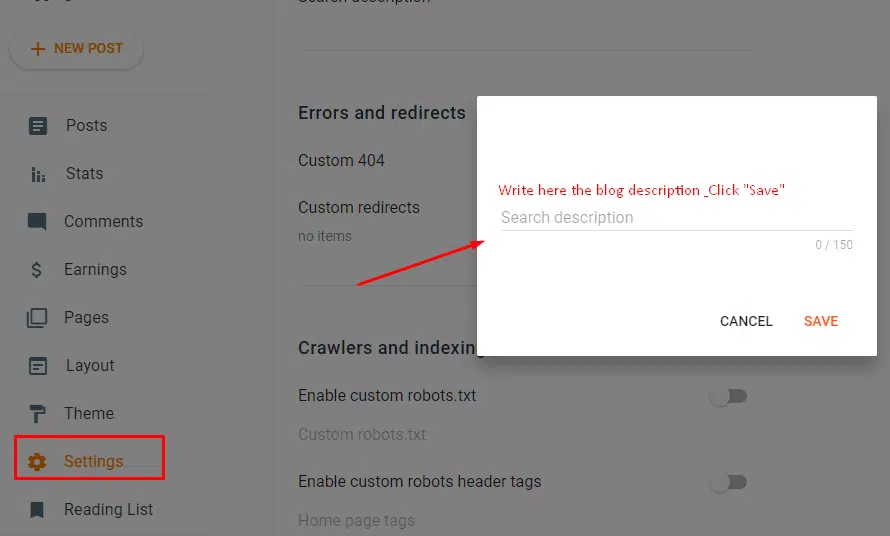
- Log in to your Blogspot dashboard
- In the left sidebar, click “Setting”. Then click on it.
- There is an option called “Search Preference” under the settings.
- The description of your blog will now be displayed on a new page.
Note: A checkbox will appear just above the description that allows you to enable search descriptions. So, it’s on now. You’ll be able to display the description in search results.
How to Write Blog Post Meta Description on the Blogspot?
You don’t need any additional SEO plugins for adding blog post meta descriptions in Blogger or Blogspot. Now let’s see how to optimize blog post descriptions using Blogspot.
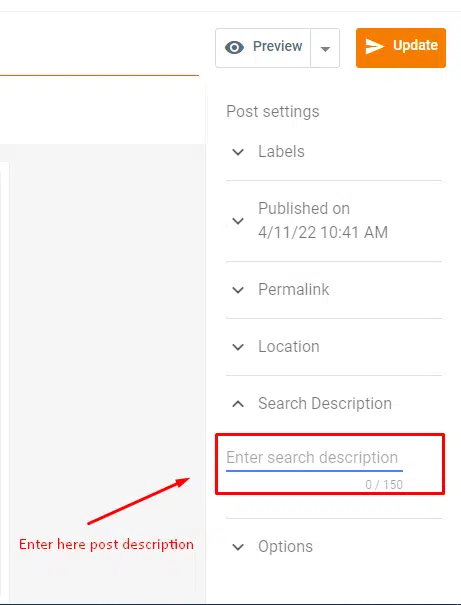
Simply follow the steps below-
- Go to the Blogger Post editor
- Look for the “Search Description” section in the right sidebar.
- Add your post meta description
- Keep the meta post description between 150 characters
- Well done! You are ready to go!
This is how you can write an attractive blog post description on Blogspot.
Top 3 Meta Description Generators
Here are the best Blog Meta Description Generators for writing unique meta descriptions-
1. Jasper AI
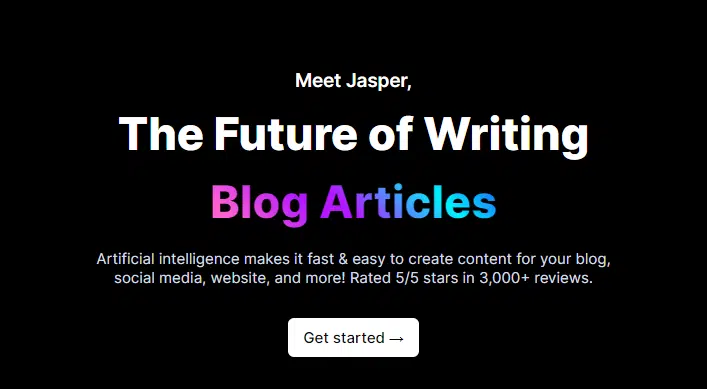
One of the best tools for creating meta descriptions is Jasper. It’s an AI writing assistant that helps to write great meta descriptions and copy that converts what Jasper helps writers and content marketers do. It offers 52+ templates that you can use to accomplish this.
The Jasper templates include templates for writing descriptions for service pages, product pages, blog homepages, and blog posts.
2. WriterSonic AI
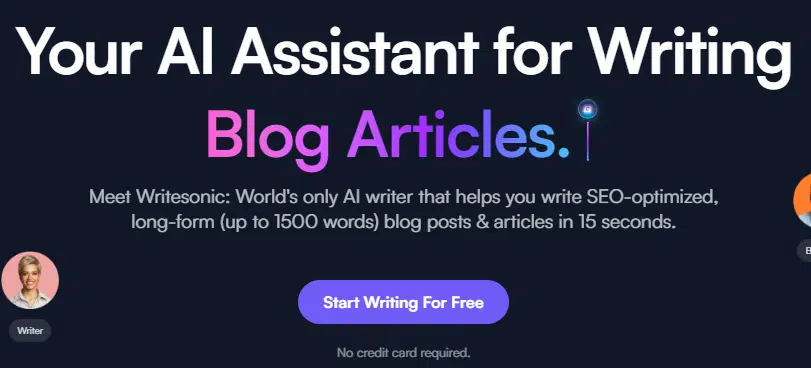
The Writesonic copywriting software is another one that is popular with many people.
The content generation technology used by Writesonic is the GPT-3 technology by OpenAI.
It also combines AI technology with 60+ copywriting tools to generate human-like content.
There is a meta tags generator for descriptions and titles included in its set of tools.
The software can generate meta descriptions and meta titles for blog posts, homepages, and product pages.
Your first step is to enter your product/business name, a short description, and a keyword for your product/business.
Once that is done, it will generate multiple copies of the meta description and title.
3. CopySmith

Copysmith may be familiar to eCommerce owners or businesses.
It’s even possible that you’ve used Copysmith for bulk product descriptions.
Did you know that Copysmith includes a meta description generator for SEO?
You can boost the rankings of your product pages with this tool.
It too uses OpenAI’s GPT-3 model as artificial intelligence.
The company combines this AI technology with its own AI wizard – Ali, allowing you to enhance your copywriting experience.
It includes 30+ copywriting tools and features to meet your content generation requirements.
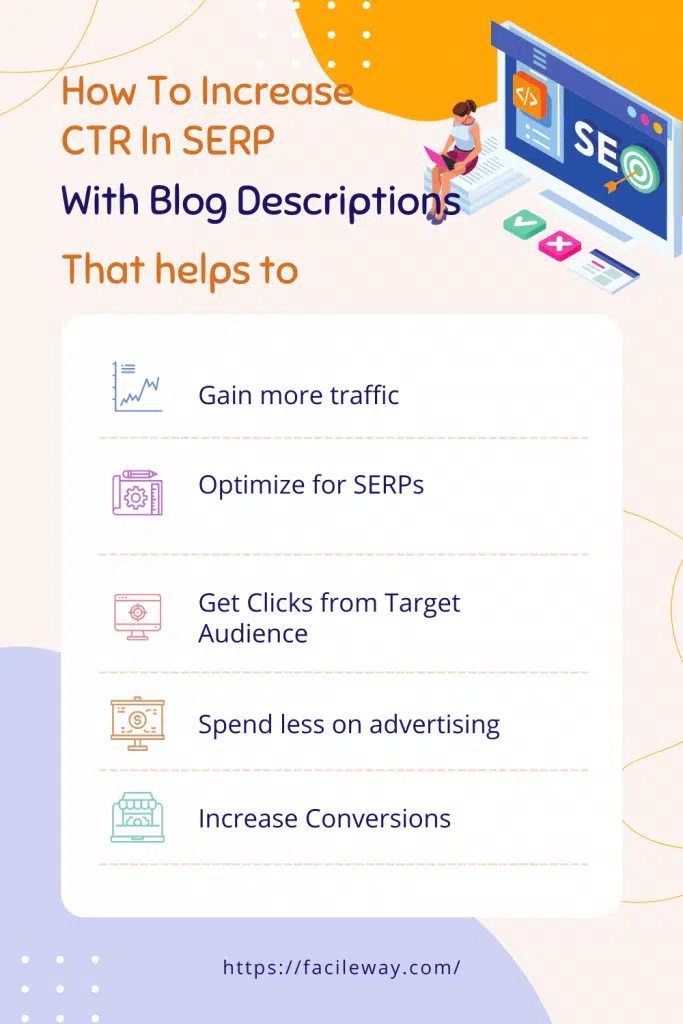
FAQs About Blog Descriptions
The following are some frequently asked questions about the blog description and blog post description-
1. What is a blog description?
The purpose of a blog description is to give a quick overview of what your blog is about. The blog description appears below the link to your website in search engine results.
2. What is the ideal length of a blog description?
The optimal Meta description length is 155 characters or less. The meta description length has fluctuated over the past few years, it should be 155 characters or less.
Your blog post description should be long enough to be sufficiently descriptive, summarise your blog post topic, and encourage readers to click through to your post
3. How does your blog’s meta description appear?
When a user searches for your website, the description of your blog appears directly under the meta title.
4. Which tool is best for writing meta descriptions?
If you’re using WordPress, install Rank Math SEO Plugin, a free optimization plugin. You can easily write and edit descriptions for your blog and individual posts using it.
5. Does blog post description matter?
There are many benefits of writing a good blog post description, including;
- Improves your CTR (click-through rate)
- Increases traffic and sales
- Optimizes your Google Adwords campaign to attract the right audience
6. Should I use keywords in the meta description?
The meta description should contain your target keyword as well as some LSI keywords that are related to your target keyword.
Final thoughts on blog post description
Your blog and individual blog posts should have powerful descriptions if you want to increase search traffic.
When creating a blog description, keep your audience in mind, analyze your competitors, and focus on benefits.
If you know how to optimize your blog post description properly, you can stay ahead of your competitors easily. You can get help from the best on-page SEO optimization tools like Surfer SEO.
It is possible to create an effective blog description for your blog posts and pages. There is a difference between a meta description and an excerpt or summary of a blog post.
When you write a blog post on Blogger or WordPress, you’ve probably come across a box for writing the blog meta description or summary.
I hope now you know you to create an effective blog description to drive more traffic to your blog.
Did I miss anything?
Please let me know and share this content on social media if you love this.

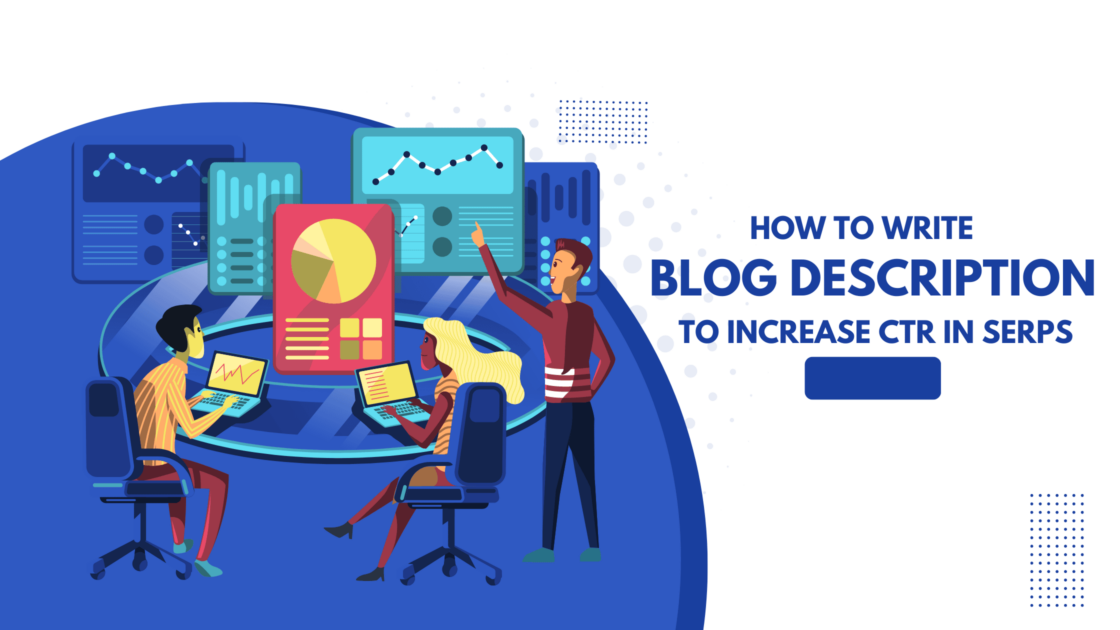

![How To Interlink Blog Posts In WordPress [3 Easy Tips]](https://facileway.com/wp-content/uploads/2022/02/Interlink-Blog-Posts-In-WordPress-768x432.png.webp)
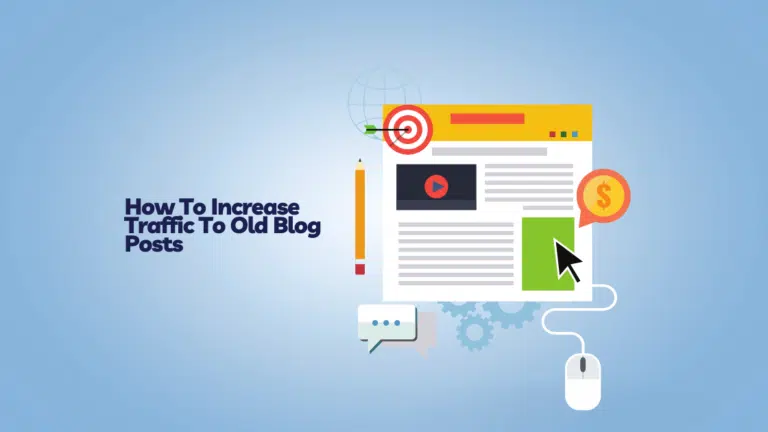

![How To Find High-Paying Keywords For Adsense [High CPC]](https://facileway.com/wp-content/uploads/2022/09/highest-paying-keywords-for-Adsense-1-768x432.png.webp)
